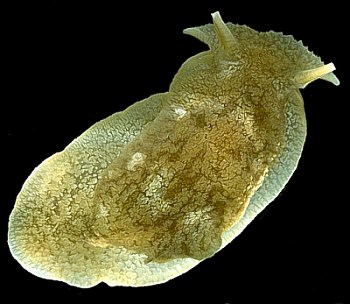
Pleurobranchaea maculata
(Quoy & Gaimard, 1832)
Order: NOTASPIDEA
Superfamily: PLEUROBRANCHOIDEA
Family: Pleurobranchidae
DISTRIBUTION
Southeastern Australia & New Zealand from the intertidal to 300m. Records from elsewhere (Japan, China, Sri Lanka) need confirmation.
PHOTO
Kurnell, Botany Bay, Sydney, New South Wales, Australia, November 1982. PHOTO: Bill Rudman.
Species of Pleurobranchaea are medium to large pleurobranchs, with a large oral veil and a reduced mantle skirt. There is no shell. Like most species of the genus Pleurobranchaea maculata has a mottled colour pattern of various shades of brown and cream. It grows to more than 10cm long.
The feeding biology of Pleurobranchaea maculata has been extensively studied in New Zealand and reviewed by Willan (1984). All studies suggest their natural diet is sea anemones including Actinia tenebrosa, Isactinia olivacea and Anthothoe albocincta. In one laboratory study a 90mm animal ate 100 Actinia tenebrosa in 3.5 days (Ottway, 1977) leading the researcher to suggest that Pleurobranchaea may be restricting the anemone to the intertidal zone through predation pressure.
All species of the genus that have been studied, are opportunistic carnivores, voracious feeders that actively forage for food. Live food is preferred and in nature consists of a wide variety of animals but seem to prefer sea anemones. They are reported to be cannibalistic at times, and in captivity easily adapt to a variety of 'convenience' foods such as chopped squid, fish pieces etc.
References.
• Ottaway, J.R. (1977). Predators of sea anemones. Tuatara, 22: 213-221.
• Ottaway, J.R. (1977). Pleurobranchaea novaezelandiae preying on Actinia tenebrosa. New Zealand Journal of Marine and Freshwater Research, 11: 125-130.
• Quoy, J.R. & Gaimard, J.P. (1832). Voyage de decouvertes de L'Astrolabe pendant les annees 1826-1827-1828-1829, sous le commandement de M.J. Dumont D'Urville, Zoologie, 2: 1-686.
• Willan,RC (1983): New Zealand side-gilled sea slugs (Opisthobranchia: Notaspidea: Pleurobranchidae). Malacologia 23(2), 221-270.
• Willan,RC (1984): A review of diets in the Notaspidea (Mollusca: Opisthobranchia). J. Mal. Soc. Aust. 6(3-4), 125-142.
• Willan,RC (1987): Phylogenetic systematics of the Notaspidea (Opisthobranchia) with reappraisal of families and genera. Am. Malacol. Union Bull. 5(2), 215-241.
Rudman, W.B., 1999 (July 28) Pleurobranchaea maculata (Quoy & Gaimard, 1832). [In] Sea Slug Forum. Australian Museum, Sydney. Available from http://www.seaslugforum.net/find/pleumacu
Related messages
Slugs killing dogs in New Zealand
October 28, 2009
From: Bill Rudman
A couple of months ago I saw reports from New Zealand of dogs in Auckland being killed by eating slugs which had washed up on beaches. At the same time this was linked with some fish kills, dead dolphins and penguins to suggest a major ecological catastrophe. The slug story was difficult to investigate because the slugs were not identified.
Since then investigators have identified the slug as Pleurobranchaea maculata and identified the toxin to tetrodotoxin, which was initially thought to be produced by puffer fish, but is now known to have a bacterial origin and has been reported in a wide variety of marine animals including the blue-ringed octopus Hapalochlaena. What is not known is whether the tetrodotoxin is always present in Pleurobranchaea or whether it is a chance result of these carnivores eating an affected carcase. However, since a number of specimens of Pleurobranchaea contained the toxin, finding the source of the toxin may be more complicated than just assuming they all fed on one carcase. If anyone has similar records of toxic Pleurobranchaea from elsewhere in the world they would be of interest.
The other example it brings to mind is the regular occurrence of toxic sea hares washing up on the beaches of Western Australia and killing dogs. Perhaps tetrodotoxin is the cause there as well [see messages on Aplysia gigantea page].
I have included two links below to reports in the NZ Herald and a pdf of the scientific report prepared by the Cawthron Institute
http://www.nzherald.co.nz/nz/news/article.cfm?c_id=1&objectid=10605795
http://www.arc.govt.nz/plans/technical-publications/technical-reports/technical-reports-2009/technical-reports-101-150.cfm
Best wishes
Bill
Pleurobranchea maculata from Victoria, Australia
September 10, 2005
From: Trevor McMurrich
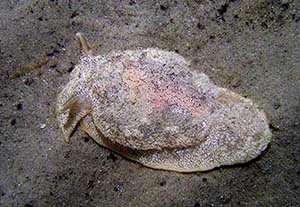
I was recently snorkelling at Portarlington Pier, Victoria, Australia just after sunset. I found dozens of Pleurobranchea maculata and many strands of eggs. I have attached a photo of eggs and one of a Pleurobranchea maculata in the process of laying them.
Locality: Portarlington Pier, Port Phillip Bay, Victoria, Australia. Depth: 1 - 3 metres. Length: 50 - 60 mm. 24 August 2005. sandbar. Photographer: Trevor McMurrich
Trevor McMurrich
trevm@leopold.vic.edu.au
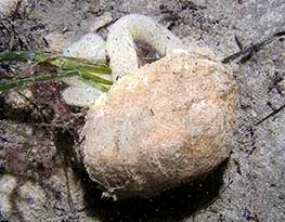
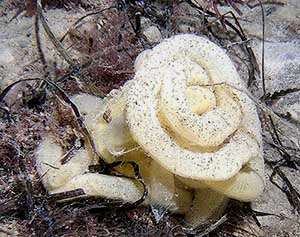
Thanks Trevor,
It would be interesting to know if they exhibited any particular mating behaviour as illustrated in Dong Bum Koh's messages [see #13642] from Sth Korea
Best wishes,
Bill Rudman
Pleurobranchaea maculata from Nelson Bay
October 22, 2003
From: Dave Harasti
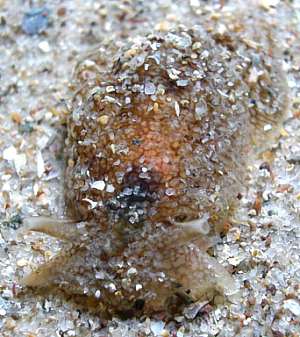
Hi Bill,
I photographed this species on a night dive at Fly Point, Port Stephens, NSW - Australia on Oct 11th 2003. Depth was 8 metres and water temp was 18 degrees. Could you please help me with an ID?
Regards,
Dave Harasti
diving@webone.com.au
Harasti, D., 2003 (Oct 22) Pleurobranchaea maculata from Nelson Bay. [Message in] Sea Slug Forum. Australian Museum, Sydney. Available from http://www.seaslugforum.net/find/11213Dear Dave.
This is Pleurobranchaea maculata. It is related to species of Pleurobranchus but its more streamlined shape fits its role as a voracious hunter and scavenger
Best wishes
Bill Rudman
Pleurobranchaea maculata from New Zealand
August 3, 2003
From: Paul Furneaux
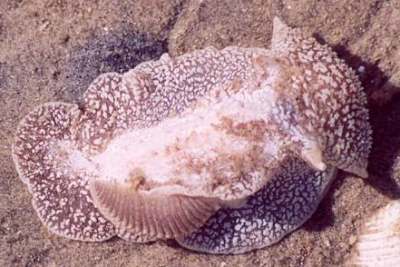
Dear Bill,
Here are some observations and photos of Pleurobranchaea maculata that I've made recently [14th to 18th July], when it was cold but clear and calm and just great for wandering over the harbour flats here in Tauranga, New Zealand.
I've noticed some unusual (to me) aspects about its behaviour. Since first reporting finding this species here in May I have regularly observed between 5 and 15 individuals (occasionally up to 25) each time that I visit the flats and this is in a fairly large area, about the size of 3 rugby fields, that is covered in Zostera and Ulva, and about 50 to 60m from the low tide mark. During this last week I have come across several individuals that appear to have suffered predator damage, but still seem able to keep going. The predator damage may have been caused by whelks – Cominella glandiformis, C. adspersa, and C. maculosa - all occur on these flats and in one instance I observed several C. glandiformis feeding on a dead Pleurobranchaea but have not seen this happen to a live animal. However, today (22 July 2003) I observed a cushion star, Asterina regularis, feeding on a live Pleurobranchaea, on the notum area. The Pleurobranchaea was definitely still alive and moved off after I separated the two animals. I'm wondering if the lower temperatures at the moment (we have had some good frosts on land lately) have slowed down these animals so that they are unable to escape the attention of the likes of Cominella or Asterina. I've included some photos to show this damage. The damaged animals also exhibited an interesting response when touched which I had not seen with undamaged animals.
The “routine” included protruding the mouth region and arching the body so that the anterior and posterior ends came upwards and almost met in the middle, a defensive reaction of some sort I suppose? Another interesting feature of their behaviour is a tendency to move in an inverted position as though they are able to cling to the surface- tension of the water's surface, photos of both of these features included.
I have a question regarding the egg mass of Pleurobranchaea maculata. I could not find any description of its egg mass on the Forum but I believe that I've seen it attached to Ulva and Zostera in this area. It is white in colour, about 5mm to 10mm in diameter, and some 10 to 20 cm long, sometimes coiled back on itself and sometimes not. I should be able to photograph it over the next few days but have no shots of this to send you as yet. Every visit to these flats seems to turn up something new or interesting, I'm currently recording the breeding activities of a group (approx 100 individuals) of Aplysia juliana and will send you some photos soon.
P.S. My “old friend” Philinopsis taronga is still around [July 2003]although its numbers have decreased and it is moving much more slowly in these colder winter temperatures. Its egg masses are still evident and I usually note around 3 to 5 individual animals on each visit, in the same area that I first came across them.
Regards,
Paul Furneaux
P.Furneaux@xtra.co.nz
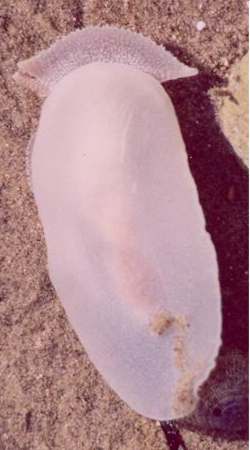
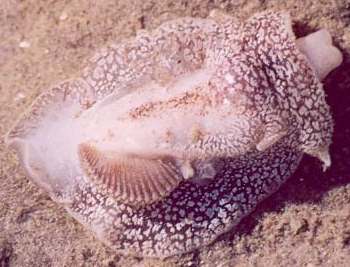
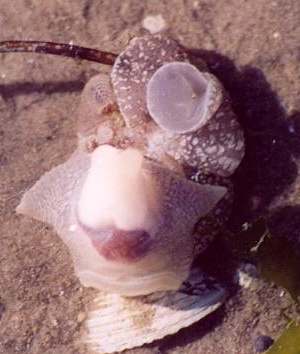
Dear paul,
Thanks for the observations. Firstly for those from strange places that don't know about rugby, Paul's study area of 'about 3 rugby fields' would be approximately 100m x 210m in total. The nature of the damage seems to fit your suggestion of starfish damage. From my knowledge, species of Cominella are more likely to be carrion feeders, often found clustered around dead carcases. I have never heard of the possible defensive postures your describe but perhaps someone who has worked on behaviour on Pleurobranchaea might have some information.
Concerning crawling upside on the surface of the water, this is quite a common behaviour of many snails and opisthobranchs, both in aquaria and pools at low tide.
Best wishes,
Bill Rudman
Pleurobranchaea maculata from Akaroa, New Zealand
June 23, 2003
From: Mark Burnett
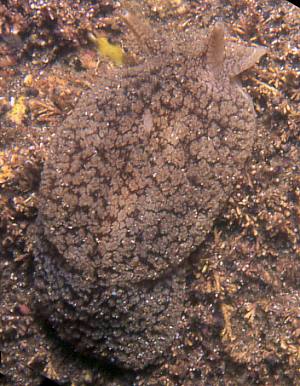
Hi Bill,
Seeing Paul Furneaux's message on Pleurobranchaea maculata reminded me of some slides I had that I took in January 1995 of the same species. They were taken in 5 metres of water at Wainui which is on the opposite side of the Akaroa Harbour from Akaroa on Banks Peninsula [east coast, South Island, New Zealand]. The water temperature was 15 deg C and the animal was about 8 cm long.
Mark Burnett
mburnett@actrix.gen.nz
Thanks Mark,
It's nice to get a South Island record. It can grow to about 10cm long, and as your photo shows, can be very difficult to see, its mottled camouflage pattern, working well in a wide range of habitats.
Best wishes,
Bill Rudman
Pleurobranchaea maculata from New Zealand
June 12, 2003
From: Paul Furneaux
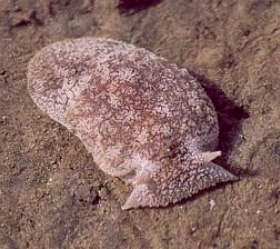
Hi Bill,
Here is a photo of what I think is Pleurobranchaea novaezelandiae. This was the first of two individuals that I encountered on 28 May 2003, and it was "at rest' until I encouraged it to move for the photo in a shallow pool in the same area of Tauranga Harbour, New Zealand that I have photographed both Philinopsis taronga and Haminoea zelandiae (mid to low- intertidal area of flats that contain extensive areas of Zostera and Ulva, off the Otumoetai Peninsula within the harbour.
I was wondering about seasonal temperature change and the activity of some of these species - do cooler temperatures favour the activity of some sea slugs?
Regards,
Paul Furneaux.
P.Furneaux@xtra.co.nz
Furneaux, P., 2003 (Jun 12) Pleurobranchaea maculata from New Zealand. [Message in] Sea Slug Forum. Australian Museum, Sydney. Available from http://www.seaslugforum.net/find/10197Dear Paul,
These species has usually been called Pleurobranchaea novaezelandiae Cheeseman, 1878 in New Zealand, but it is generally considered to be the same as the more widespread Pleurobranchaea maculata, which was named 40 years earlier.
Concerning the effect of temperature on the activity of sea slugs. I don't think there is a simple answer. Some are more abundant during the winter while others seem to prefer warmer weather. Many species have an early Spring breeding season, and some have a second, but smaller breeding season in Autumn.
Best wishes,
Bill Rudman
Pleurobranchea maculata from S.E. Australia
July 31, 2002
From: John Chuk
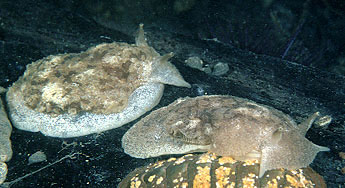
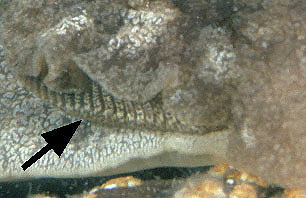
Dear Bill,
Here is an image of two specimens of Pleurobranchea maculata photographed at Flinders pier, Victoria, Australia, on April 29, 1995. They were two of a group of four specimens found under a piece of timber lying on the bottom beneath the pier at a depth of 4m. I did not record the size of these specimens but suspect they are in the 70 to 80mm range.
I have included a close up of a portion of the right side of the specimen in the foreground, as a portion of the gill (arrowed) is visible below the mantle margin.
Best wishes,
John.
jchuk@giant.net.au
Chuk, J., 2002 (Jul 31) Pleurobranchea maculata from S.E. Australia. [Message in] Sea Slug Forum. Australian Museum, Sydney. Available from http://www.seaslugforum.net/find/7661Thanks John,
Bill Rudman
Pleurobranchaea maculata from Australia
July 29, 1999
From: Bill Rudman
I have prepared a page on Pleurobranchaea maculata from Australia and New Zealand to accompany Betsey Hansen's message about a Pleurobranchaea from New York.
Bill Rudman.
